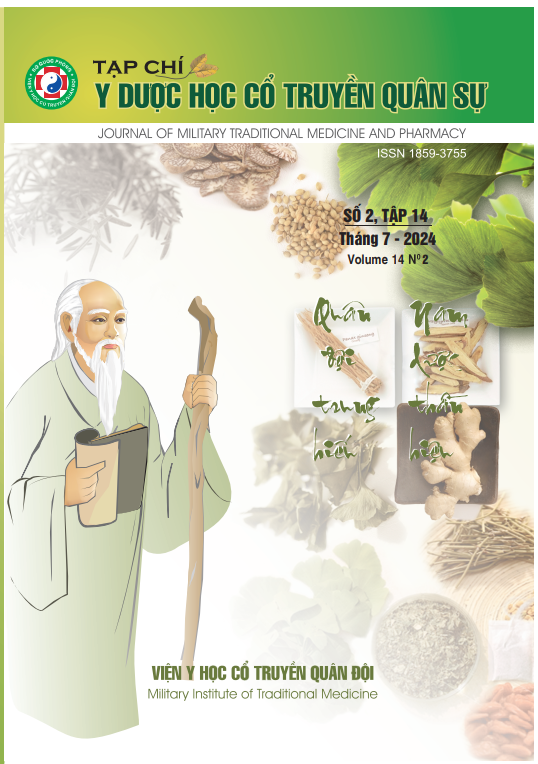ĐẶC ĐIỂM TUYẾN TIỀN LIỆT TRÊN SIÊU ÂM VÀ MỐI LIÊN QUAN VỚI CÁC TRIỆU CHỨNG RỐI LOẠN TIỂU TIỆN CỦA CÁC BỆNH NHÂN KHÁM TẠI VIỆN Y HỌC CỔ TRUYỀN QUÂN ĐỘI
Main Article Content
Abstract
Objective: To investigate prostate characteristics on ultrasound and the relationship with symptoms of urinary disorders in patients. Method: cross-sectional description of prostate characteristics on transabdominal ultrasound of 1326 male patients over 40 years old from 9/2020 - 3/2021 combined with a questionnaire on symptoms of urinary disorders according to IPSS and QoL scales. Results: mean age 65.11 ± 10.96; Average prostate weight 32.67 ± 16.70 grams; Correlation coefficient r = 0.353 (p<0.05) between age and prostate weight. The rate of prostatic hypertrophy (BPH) is 63.2%; accounting for 25.6% at age 40; 52.9% at age 50; 65.7% at age 60; 74.1% at age 70 and 80.6% at age 80 and older. Patients with BPH have an average IPSS score of 12.11 ± 9.18; having mild urinary disorders (1-7 scores) is 26.5%; moderate (8-19 scores) is 36.8%; severe (20-35 scores) is 25.5%; without urinary disorders is 11.5%; has an average impact on quality of life (QoL) of 2.09 ± 1.79 scores; mild (1-2 scores) is 21.7%; moderate (3-4 scores) is 46.7%; severe (5-6 scores) is 13.8%; no effect is 17.8%.
Article Details
Keywords
Prostate ultrasound, benign prostatic hypertrophy, unirary disorder.
References
2. Nguyễn Bửu Triều (2004), U xơ tuyến tiền liệt, Bách khoa thư bệnh học, Nhà xuất bản từ điển bách khoa, 291 - 294.
3. Ojewola R.W., Oridota E.S. et al (2017). Prevalence of clinical benign prostatic hyperplasia amongst community-dwelling men in a South-Western Nigerian rural setting: A cross-sectional study, African Journal of Urology, 23 (2), 109-115.
4. Lại Thanh Hiền (2017). Nghiên cứu độc tính và hiệu quả của cốm “Tiền liệt HC” trong điều trị phì đại tuyến tiền liệt. Luận án Tiến sỹ Y học, Trường Đại học Y Hà Nội.
5. Nguyễn Hoài Bắc, Hạ Hồng Cường, Hoàng Long (2021). Khảo sát thể tích tuyến tiền liệt ở nam giới trên 45 tuổi tại Bệnh viện Đại học Y Hà Nội, Tạp chí Y học Việt Nam, 498, 213 - 217.
6. Trần Đức Thọ, Đỗ Thị Khánh Hỷ (2008). Tình hình u phì đại tuyến tiền liệt ở người Việt Nam. Tạp chí Y học Việt Nam, 1, 47 – 52.
7. Claus G., Roehrborn. MD., Campbell Walsh (2011). Benign Prostatic Hyperplasia: Etiology, Pathophysiology, Epidemiology, and Natural History. Urology, 10, 2570 - 2610
8. Nguyễn Vinh Quốc, Nguyễn Bá Quế (2019), Nhận xét đặc điểm bệnh nhân phì đại lành tính tuyến tiền liệt điều trị tại Viện Y học cổ truyền Quân đội, Tạp chí Y dược học quân sự 2019.
9. Hayder Q. Al-Mosawi, et. al., (2020) Accuracy of Intravesical Prostate Protrusion Measured by Trans-abdominal Ultrasound in Predicting Bladder Outlet Obstruction, International Journal of Pharmaceutical Research, Vol 12, 1150 – 1156.
10. Trần Lập Công (2011). Nghiên cứu hiệu quả điều trị phì đại lành tính tuyến tiền liệt của trà tan Thủy long, Luận án tiến sĩ Y học, Trường Đại học Y Hà Nội, 66 – 82.


